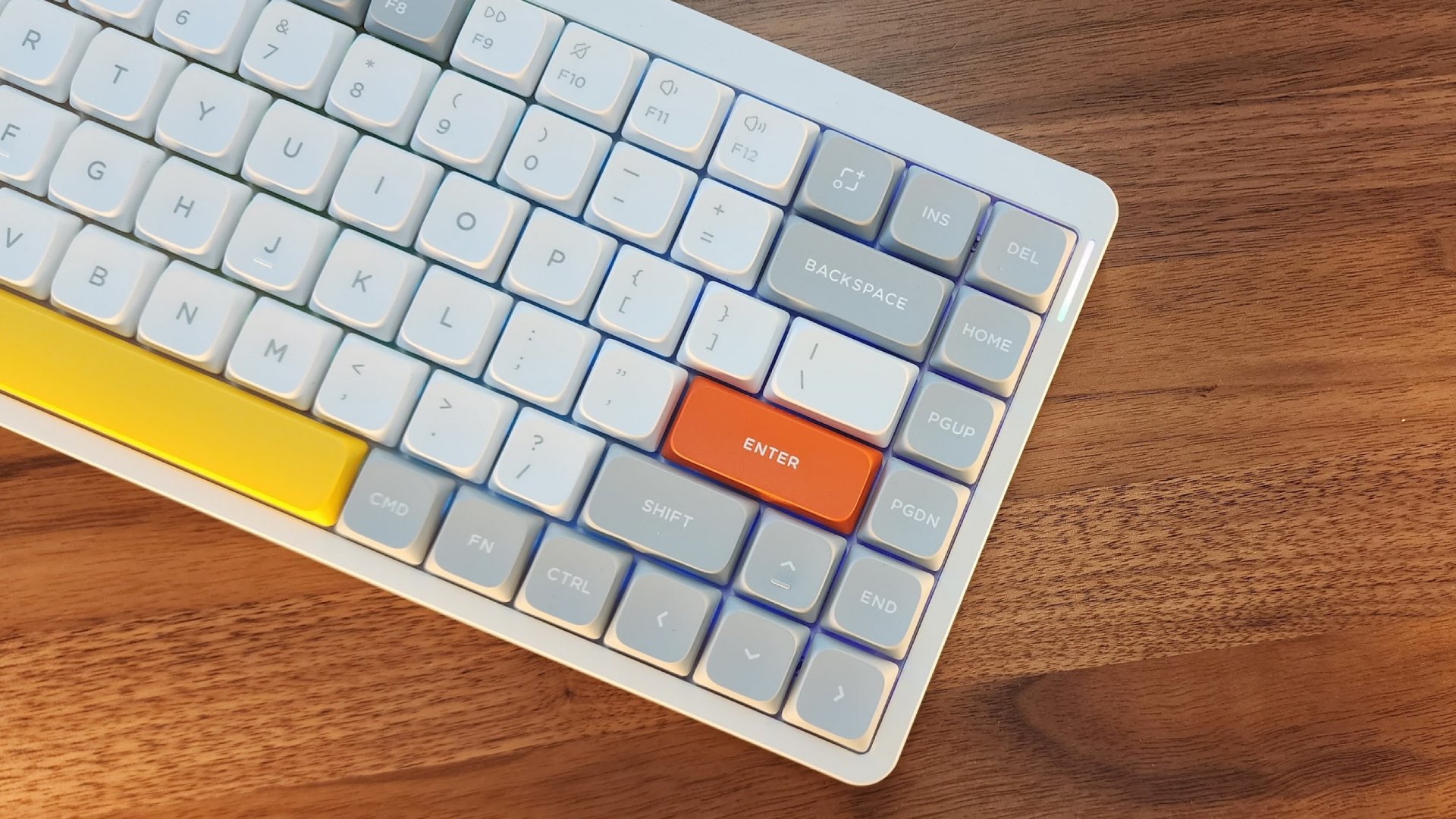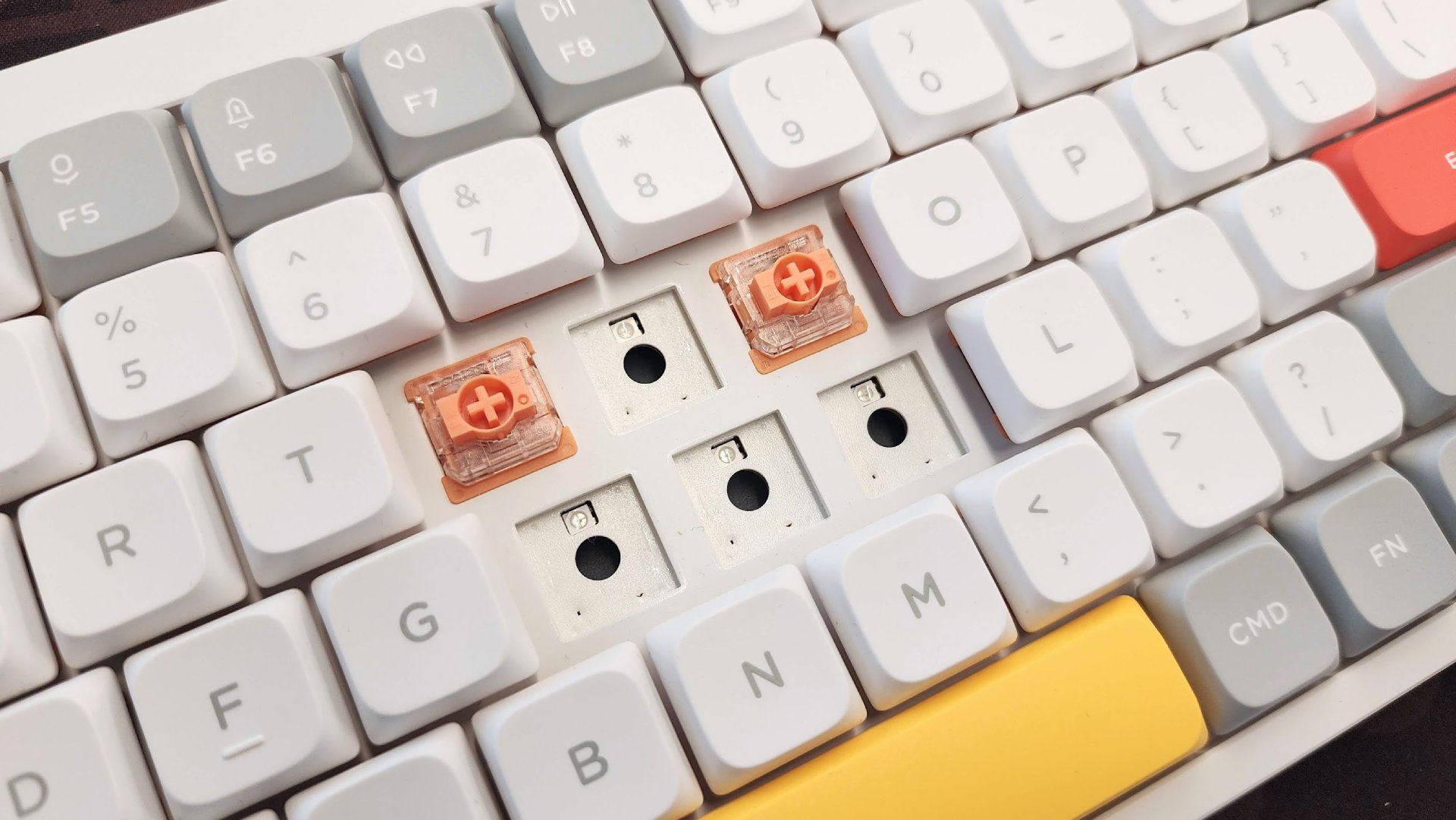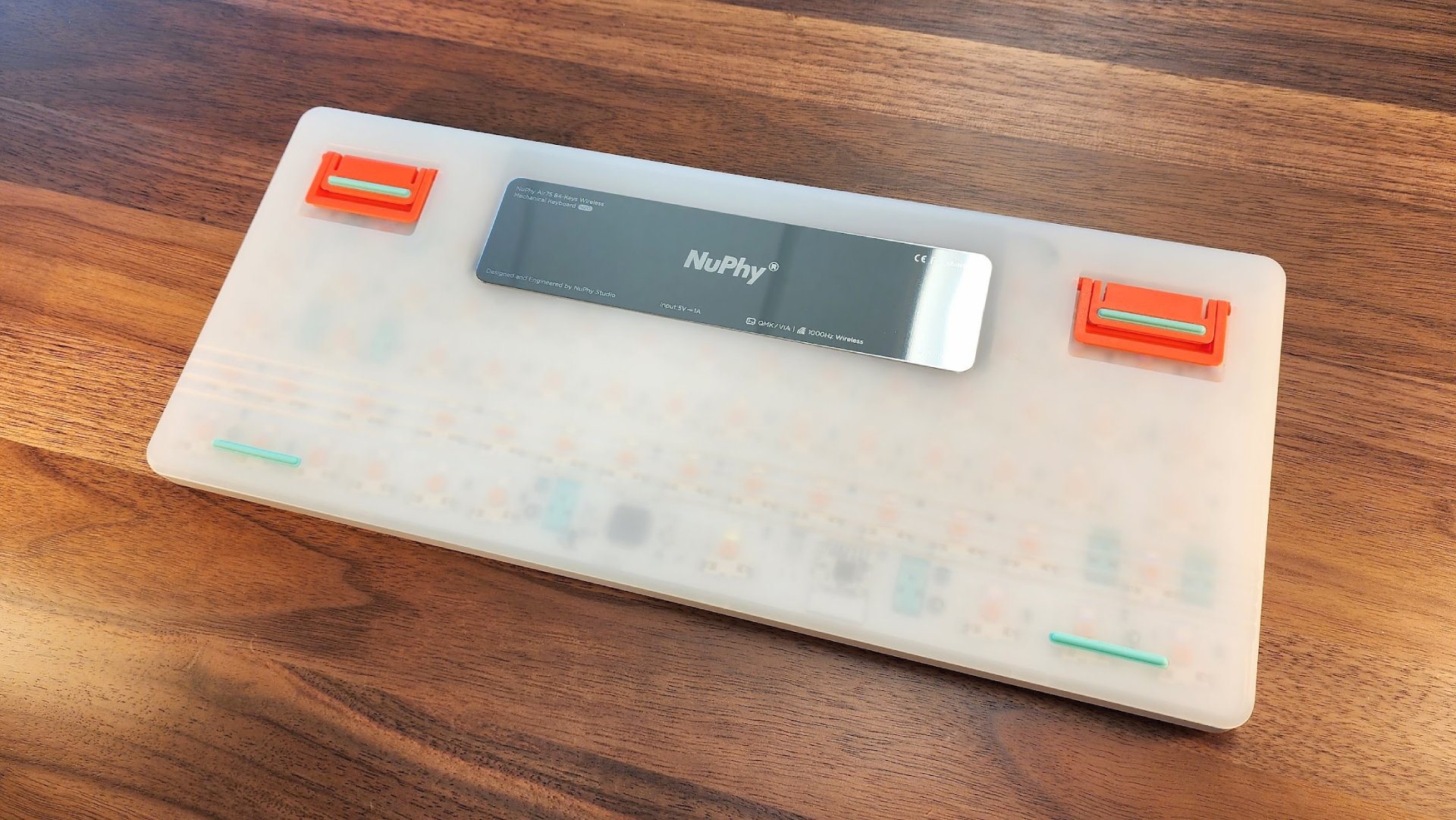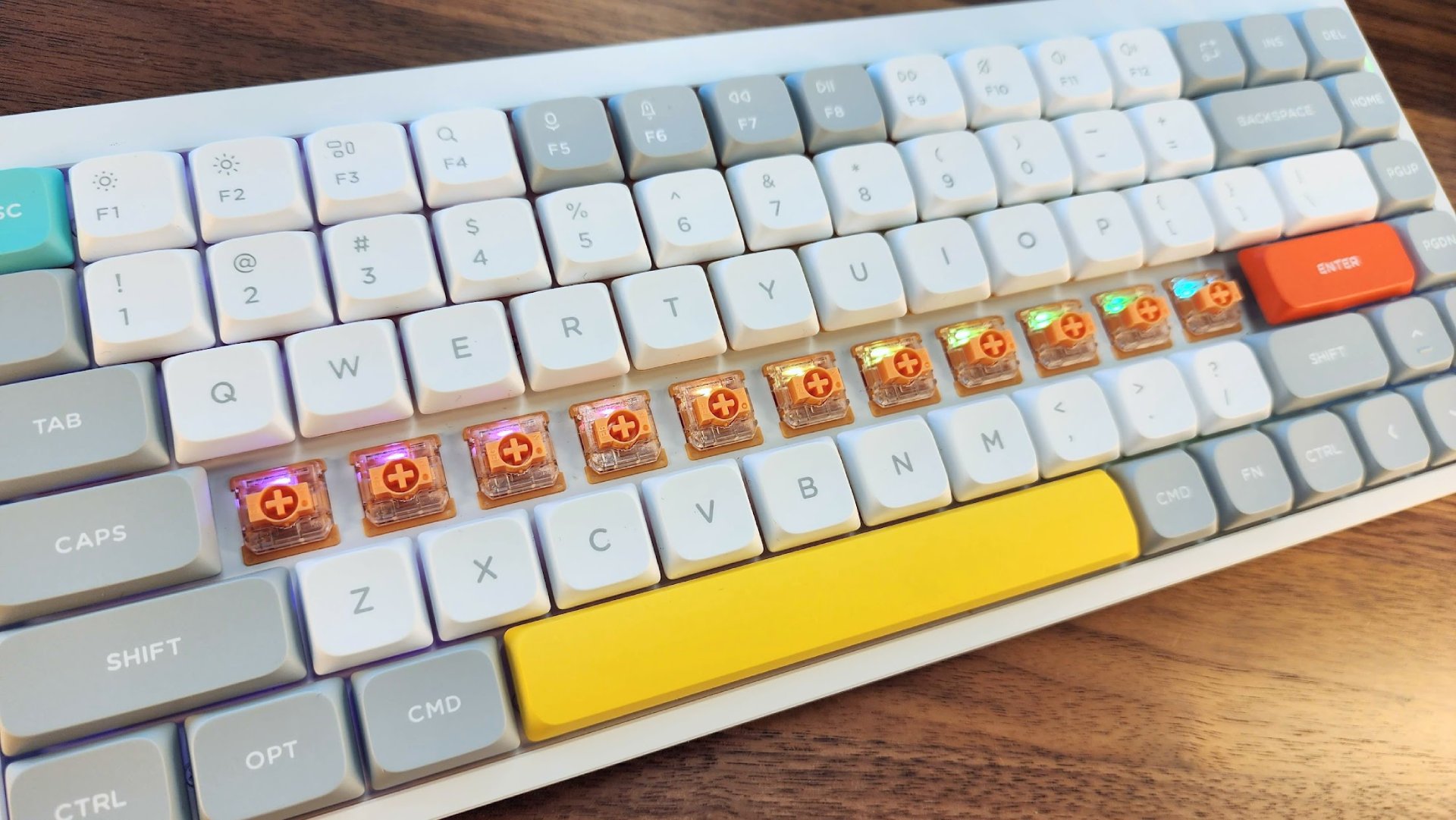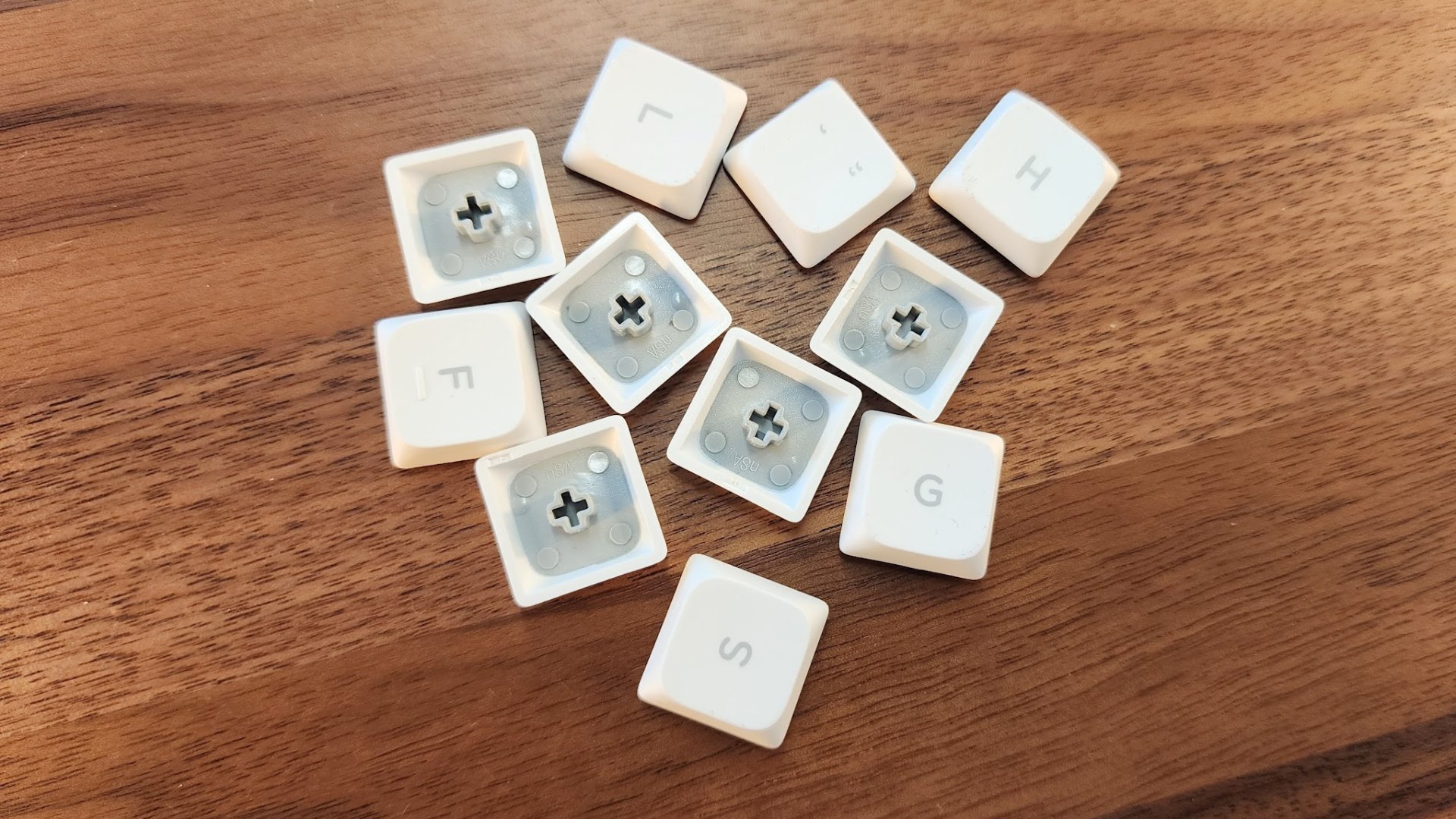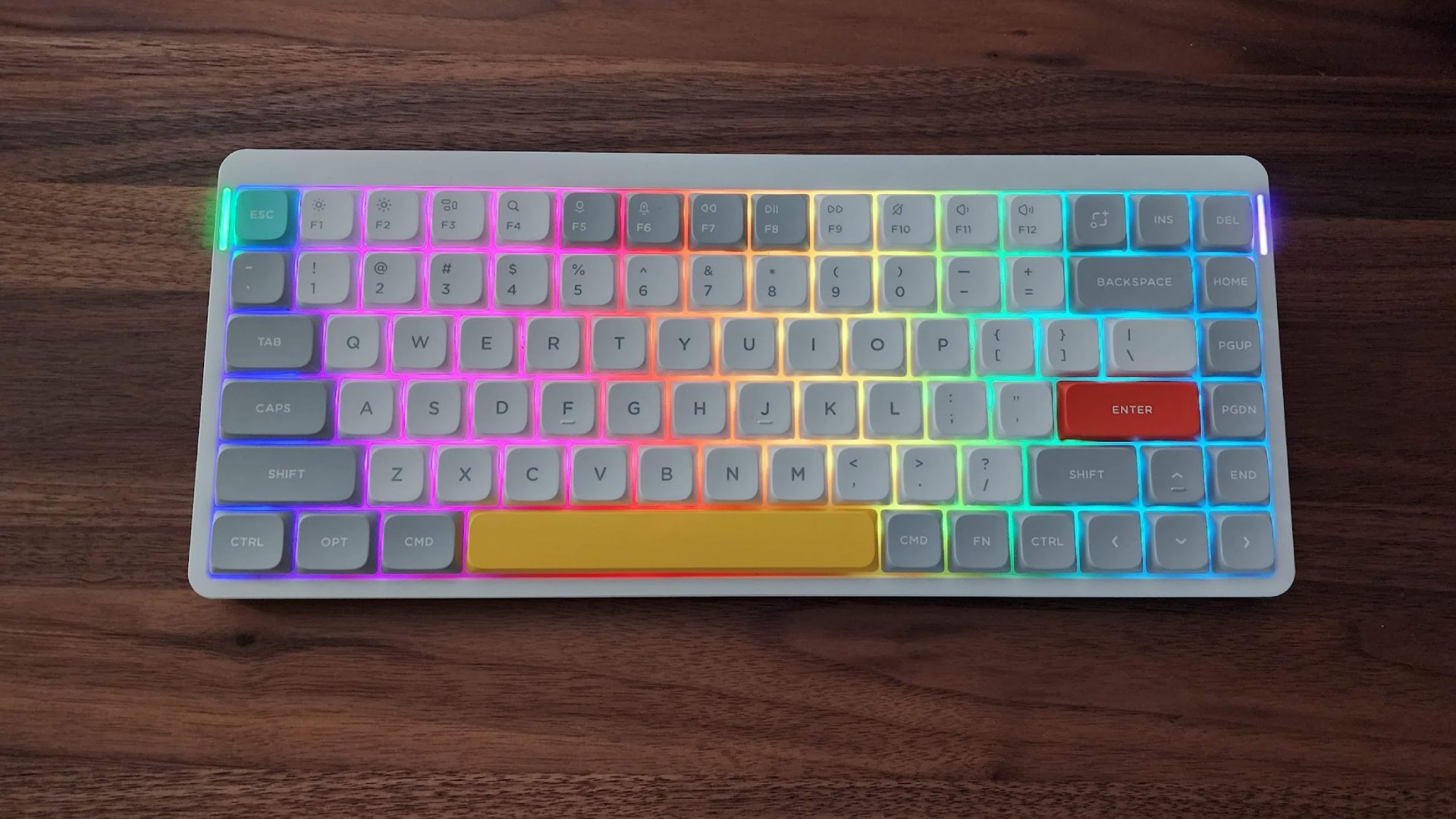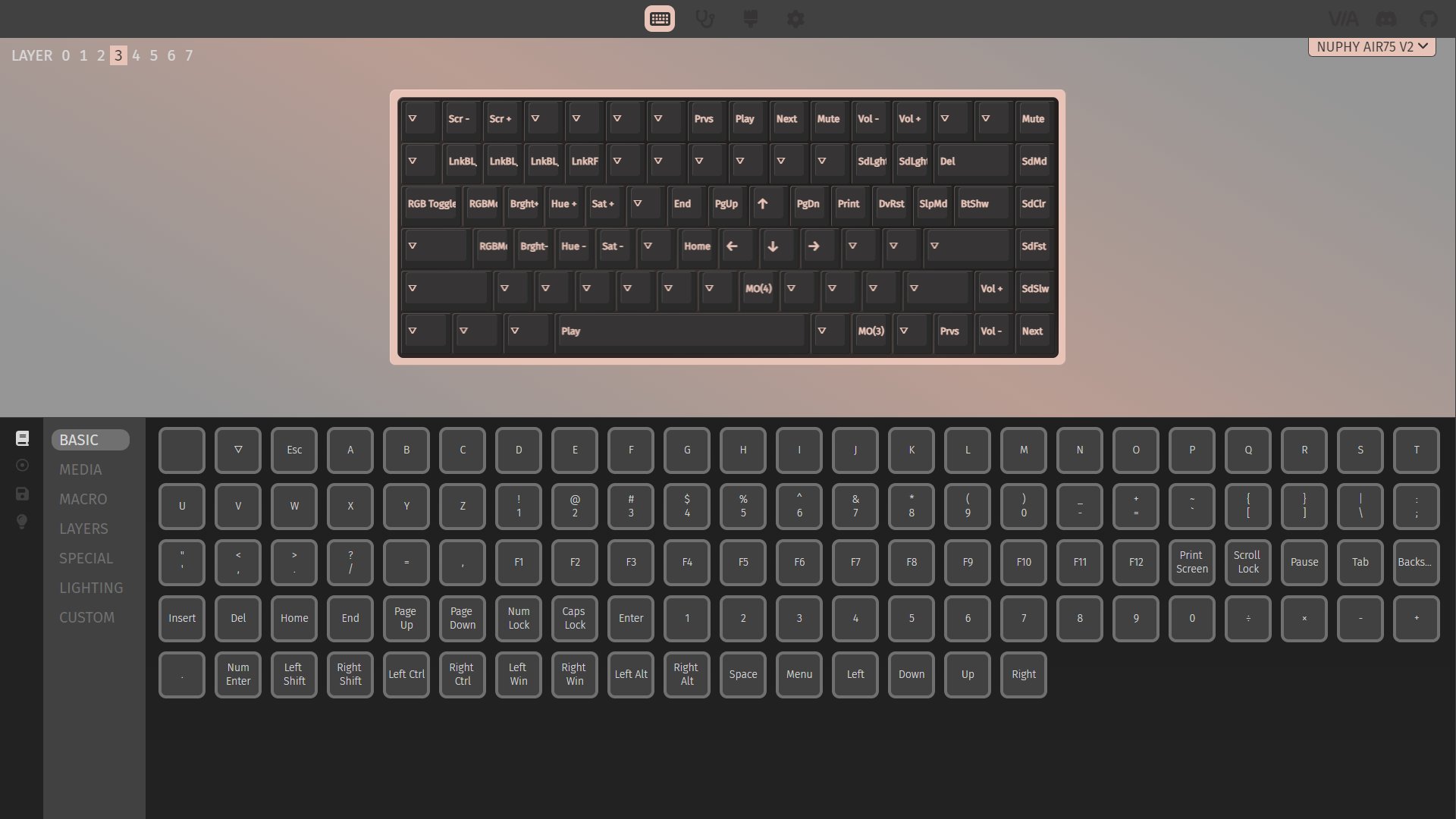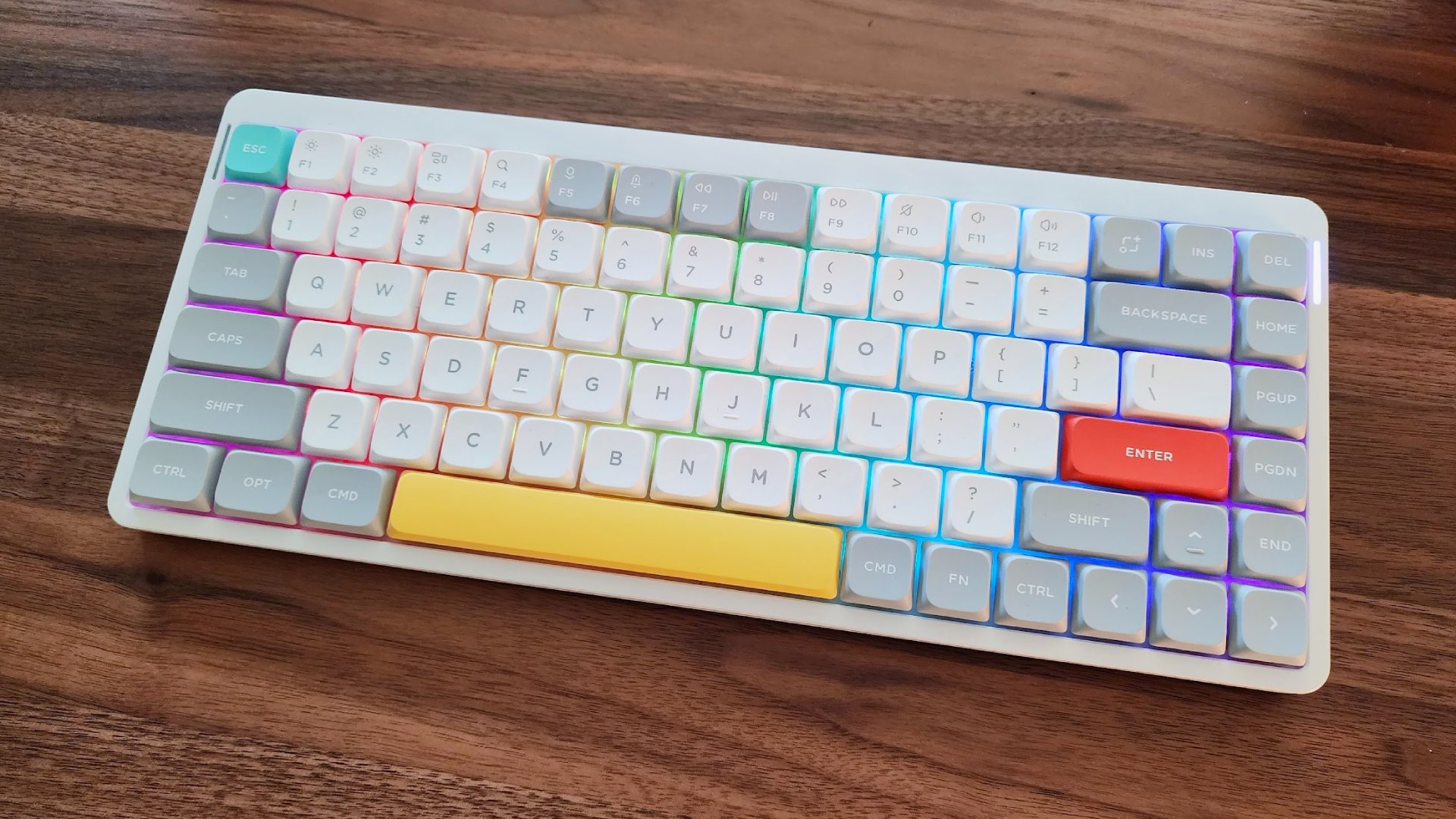Tom's Hardware Verdict
The Nuphy Air75 V2 improves upon the original in meaningful ways, offering better battery life, more switch options, faster wireless for gaming, and brighter RGB. It’s one of the best low-profile mechanical keyboards you can buy.
Pros
- +
Much better battery life
- +
Great keycaps and improved switches
- +
1ms wireless for gaming
- +
Improved sound and feel
Cons
- -
Benefits from a palm rest (not included)
- -
Flat keycap profile takes some getting used to
Why you can trust Tom's Hardware
The original Nuphy Air75 became something of an Instagram hit due to its clean yet colorful aesthetics and Mac-friendly design. It also helped that there was substance behind the style, entering the market as one of the first low-profile keyboards with thick, dye-sublimated PBT keycaps, catching the eye of many keyboard enthusiasts and social media influencers.
Nuphy wasn’t content to rest on its laurels, however, and just released its successor: the Nuphy Air75 V2. While it might look the same on the surface, this new version brings with it big improvements to battery life, wireless connectivity, build quality, and the typing experience. It’s also the first tri-mode wireless keyboard to support QMK/VIA programming, showing that Nuphy is still learning lessons from the enthusiast community, and has its eyes on making the Air75 V2 one of the best wireless keyboards you can buy.
Nuphy Air75 V2 Specs
| Switches | Row 0 - Cell 1 |
| Lighting | (Ex: Per-key RGB) |
| Onboard Storage | 8 layers of keymaps |
| Media Keys | Secondary functions |
| Connectivity | 2.4GHz wireless, Bluetooth 5.0, wired (USB-C) |
| Additional Ports | 0 |
| Keycaps | Doubleshot PBT |
| Construction | Aluminum top, plastic bottom |
| Software | QMK/VIA |
| Dimensions (LxWxH) | 12.5 x 5.2 x 0.59 inches (316.4 x 132.5 x 13.5 mm) |
| Weight | 1.31 pounds (598 grams) |
| MSRP / Price at Time of Review | $119.95 |
| Release Date | Q3 2023 |
Design
At a glance, the Air75 and Air75 V2 have a lot in common. Both keyboards feature a 75-percent (compact TKL) layout that includes a full function row, arrow keys, and a column of navigation and editing buttons. They’re both remarkably thin, though the V2 is a few millimeters shorter at 13.5mm (the original was 16mm). Both feature minimalist colorways with splashes of color on the Escape, Enter, and Spacebar keys. Even their USB Type-C ports and toggles for Windows or Mac, Wired or Wireless are the exact same color and in the same position along the back edge of the keyboard.
Nuphy followed the adage of “if it ain’t broke… ” with the overall design, and I think most fans would agree that’s a good thing. The Air75 and Air75 V2 are functional, well-built keyboards that are just about perfect for travel (and can be used just as well at your desk). This new model is available in three colors — Ionic White, Basalt Black, and Lunar Grey — instead of the singular grey option of the original. The top half of the case is still made of sturdy aluminum and the bottom of frosted plastic.
But don’t let those similarities fool you. The Air75 V2 is brimming with upgrades. The keycaps have been upgraded to doubleshot PBT and have crisper legends than the original. They’re even more durable, too, and should still look like new years into the future with proper care.
Instead of the typical red (linear), brown (tactile), and blue (clicky) switch options of the V1, this model now comes with improved 2.0 versions of each, which decreases stem wobble, adds travel distance to make them feel even closer to full height mechanical switches, and are pre-lubed. Nuphy also has four of its own flower-inspired switches available: Aloe (linear, 37gf of actuation force), Cowberry (linear, 45gf of actuation force), Wisteria (tactile, 55gf of actuation force), and Moss (tactile, 60gf of actuation force). My unit was sent with Daisy 2.0 switches, which are 48gf linears, though these aren’t currently available on the company’s website. These switches are all pre-lubed and feature long-pole stems for a cleaner, staccato sound signature with plenty of pop.
These switches are all hot-swappable, just like last time, which means you can simply plug and unplug them without the need for a soldering gun. With more options to choose from, the ability to swap out is actually beneficial when last time most people just chose linear, tactile, or clicky and stuck with it. Note that the sockets are only compatible with Gateron low-profile switches, so Kailh Chocs won’t work.
Get Tom's Hardware's best news and in-depth reviews, straight to your inbox.
The typing experience is improved simply by having more options to cater to your personal taste, but Nuphy has also added layers of sound-dampening and acoustic tuning material to the Air75. You wouldn’t think it possible in such a thin frame, but there’s actually two separate layers of foam built into the keyboard to tune its sound signature. PORON plate foam absorbs reverberations and helps isolate the sound of the switches. Another layer of IXPE foam sits below the switches themselves to add a creaminess and pop to the sound. There is no case foam, but since the case is so thin, it doesn’t need any more dampening to ward off hollowness.
Then there’s the small touches, like the pre-lubed Cherry-style stabilizers that ward off any rattle from the larger keys. If you do find they need tuning, you can simply pull them off and press a new one into place. Or the fact that there are silicone plugs beneath the Spacebar to decrease its volume, similar to the Ghostbar on the Nuphy Halo series.
Flipping the keyboard over, I was also pleased to see that Nuphy dropped the removable magnetic feet and went with traditional tilt feet on this version. The magnetic ones had a tendency to pop off when sliding it along a desk. Even with this change, the keyboard can still be used directly on top of a laptop deck thanks to thin strips of silicone Nuphy calls AirFeet. These allow you to position the keyboard to type without mashing the built-in keys on your notebook.
Another major upgrade arriving with this model is aimed directly at gamers: 1,000Hz wireless polling. Using the 2.4GHz dongle, the prior model was limited to 500Hz. It was usable while gaming but if you crave every advantage, you probably pushed the V1 to the side in favor of your normal gaming keyboard. That’s no longer a problem here.
The Nuphy Air75 V2 still supports Bluetooth 5.0 with up to three devices, just like last time, but the battery has almost doubled in size. It’s now 4000mAh (up from 2500mAh). Nuphy says this raises maximum battery life from “around 48 hours” to up to 220 hours. This is with RGB off, and enabling the light show expectedly drops that a ton. With full backlighting, you can expect 35 to 57 hours between charges. There are small RGB strips in both corners, and the right one acts as a battery indicator with a quick key combination – or it can be locked to display battery status at all times.
If you’re using the keyboard in a bright room, however, it’s still not worth leaving the RGB on. The keycaps aren’t backlit and generally block most of the lighting. With a darker setting (like my office with only a floor lamp on), the lighting can look really nice. It’s much brighter than the V1 and incorporates new diffusion elements to reflect its colorful lighting from the edges back toward the keys. I leave it off during the day to save on battery and turn it on when I’m in more relaxed lighting.
The keyboard is also natively compatible with Mac or Windows and includes alternate keycaps for each. Its programming software, VIA, is also available for both operating systems, so you’re not limited by opting for one over the other.
Typing Experience of the Nuphy Air75
Typing on the Nuphy Air75 V2 is surprisingly good. Before the original Air75, I wasn’t a big fan of low-profile keys. I could use them, and frequently worked from a laptop, but give me a full-size mechanical keyboard any day of the week. But the V2, like its predecessor, strikes an excellent middle-ground between being low profile and still feeling fully mechanical.
Much of this is because of the travel distance on the switches. Despite being about half the height of a proper MX-style key switch, they feature 75 to 80 percent of the travel distance, depending on your choice of switch. It’s more than twice the distance of Kailh’s line of Choc low-profile switches. It is noticeably less, but also makes using the Air75 V2 feel immediately more familiar and easy to adapt to than other low-profile mechanical keyboards.
Because the mounting style and travel distance are the same, typing on the V2 feels almost identical to the V1. The keys are smooth thanks to the pre-lubing and have a firm bottom-out. The thick PBT keycaps give a sense of solidity to the typing experience and are scooped enough to cradle the fingertips. That’s important because the key profile is totally flat and could be especially prone to typos otherwise. There’s still a slight learning curve, so I wish there was some kind of curvature between rows, but it’s genuinely nothing an hour or two of use soundn’t rectify for most people.
The biggest improvement comes with the sound signature of the keyboard. The new layers of PORON and IXPE foam lend it a deeper, more full-bodied sound. It’s quieter than most full-size mechanical keyboards, but not by much. The long pole switches add a bit of definition to each keystroke and a noticeable poppiness. I still might tape mod it, though, just to see how that further refines its sound.
The only thing I was left wishing for was a palm rest was included in the box. With such a low profile, it doesn’t explicitly need one, but Nuphy’s custom low-height rest definitely makes typing more comfortable overall and lowers the learning curve for its flat profile.
Gaming Experience of the Nuphy Air75 V2
I still contend that the Air models aren’t truly gaming keyboards, but with the speed improvements to the 2.4GHz connection, I had to take the Air V2 for a spin. It works exactly as you would expect it to: Using the dongle, its 1ms of latency is indiscernible from a wired gaming keyboard. I played through several rounds of Battlebit: Remastered, swapping between the Air75 V2 and my kingly Corsair K100 RGB gaming keyboard, and there was no difference at all in responsiveness that I could feel.
The Air’s size is especially good for gaming. The 75-percent layout leaves plenty of space for wide mouse movements while still providing extra keys that can be remapped to in-game functions. The software makes remapping keys easy and actually supports eight layers of full remaps, so you can have key sets for individual games. It also supports macros but is limited to text strings without memorizing cumbersome keycodes, so isn’t something you can really use on the fly.
Software for the Nuphy Air75 V2
Unlike the original Air75, the V2 uses the open-source firmware, VIA, for all of its remapping. It’s very convenient and doesn’t even require a software download now that the web client is available. You will need to download the JSON file from Nuphy’s website and upload it for the keyboard to be recognized, however.
Once it’s loaded, you’re given a simple graphical version of the keyboard with all of the remapping options displayed below. It provides full access to basic inputs, media controls, lighting options, and Windows shortcuts for things like the Calculator and This PC. Nuphy also has some custom options to control the small RGB strips, reposition the wireless connectivity toggles, reset the keyboard, and so on. To remap a key, all you need to do is click the key you’d like to change and select what you’d like there instead. These changes save to the keyboard automatically and will work with any PC without any additional software required.
VIA is very popular within the keyboard community for the freedom it provides. Changes can be saved across eight layers, with multiple options for how to access them. My most frequently used option is to hold a button to access secondary commands, similar to how Shift works with the number row, but you can also use tap to toggle, tap and single key press, and more. If you get creative, it’s very freeing.
The only downside is that since VIA is designed to work with many different keyboards, some of its options are more limiting. You can’t easily set a custom static lighting scene, for example. Recording macros, as I mentioned before, is also very limited. If you don’t need long macro strings or don’t mind setting your keyboard to one color or animation, it’s pretty fantastic.
Bottom Line
The Nuphy Air75 V2 is what all great successors should be. It carries through everything that made the original great and builds on it. It provides more options, more uptime, better lighting, and better connectivity, while still being affordable at $120.
Of course, if you’re just in it for gaming, VIA is going to feel pretty limiting. The Corsair K100 Air Wireless is a great alternative with an even slimmer frame (but wider footprint). If you’re all in on responsiveness, the Razer Deathstalker V2 Pro is also worth considering thanks to its fast optical switches.
If you’re looking for a compact option, though, neither of those alternatives are going to fit the bill. The fact is, the Nuphy Air75 V2 checks just about every box you’d hope it would. For fans of low-profile keys, this is truly an exceptional buy.
MORE: Best Gaming Keyboards
MORE: How to Pick Keycaps for Your Mechanical Keyboard
MORE: How to Build a Custom Mechanical Keyboard

Chris is a regular contributor for Tom’s Hardware, covering mechanical keyboards, peripherals, and content creation gear.
-
splus And not a single photo of the keyboard from a side, so we can actually see how thin this low profile keyboard is? Looks like any regular thick keyboard.Reply


